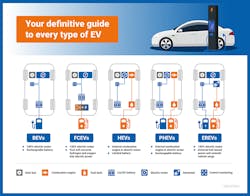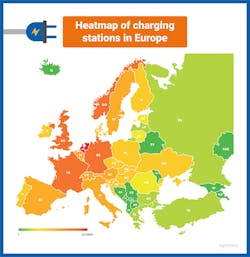What you’ll learn:
- The government incentives available for current and prospective EV owners across Europe.
- What the charging infrastructure looks like across Europe.
- How to identify the different types of electric cars on the market today.
Europe is on its way toward a green revolution in transportation. The combination of technology, ecology, and government incentives appears to be working well, as plug-in electric vehicles are on their way to become the global majority by 2040. But is the current rate of transition enough to alleviate the immediate threats associated with global warming? What can be and is being done to turn prospective buyers in favor of the electric motor?
What’s Available?
Initially, only few drivers could afford a fully electric vehicle or hybrid. Recently, though, the automotive industry has introduced more affordable cars. Coupled with government incentives in the form of direct subsidies, tax benefits, and charging infrastructure, what followed was an electromobility boom across Europe.
Be it the plug-in superstars, BEVs and PHEVs, the novel hydrogen-powered FCEVs, or the more traditional HEVs, today’s eco-friendly drivers are really spoiled when it comes to choosing the type of EV they want (Fig. 1). But don’t take our word for it. To truly grasp the diversity of the sector, take a look at the figure and review your knowledge of electric cars in the process.
Aside from the flood of incentives coming their way, more and more drivers also choose EVs over internal combustion engine cars because of:
- Sustainability and ecology: Electric propulsion doesn’t cause pollution.
- Energy efficiency: The electric motor is particularly superior when it comes to torque.
- Safety: The lower center of gravity in EVs increases drivers' overall control.
Charging Matters
The ownership of electric cars is often associated with range anxiety due to battery range, which is why charging infrastructure is such a paramount factor in electromobility. Though we can charge BEVs and PHEVs from an ordinary socket at home or work, with up to eight hours until full battery, this is far from ideal. Level 2 and DC/fast chargers can do the same within four or two hours, respectively, but their availability depends on the country.
In 2019, there were 144,000 charging points of all kinds across the European Union. Of those, 26% were located in the Netherlands, giving the country an excellent proportion of one charging station per six EVs—four cars less than the EU-recommended ratio of one charging station per 10 electric cars. Germany came in second with 19%, followed by France’s 17%, while the UK barely missed the podium with 13%. The opposite end featured disappointing results from the likes of Greece, the Baltic States, Bulgaria, and Romania, with just 0.1% a piece.
2020 saw further development of the European charging network. Most of the progress in absolute numbers unsurprisingly occurred in the Netherlands, skyrocketing from 37,000 to 60,000 charging stations. Headed in the right direction, Romania introduced nearly 70 charging points—a 60% increase from last year—resulting in a total of 190.
The European Race for Electromobility
The Netherlands may have the lion’s share of charging stations in Europe, but once we analyze electromobility as a whole, one nation stands high above the rest. Indeed, we’re talking about Norway (Fig. 2). The Nordic country is a forward-thinker and trend-setter in many fields, with ecological transportation being one of them. Its number of passenger plug-in EV registrations for the first half of 2020 sits at an astonishing 68.5%. That’s 25% more than Iceland, which came in second place.
But the rest of Europe is steadily catching up. In 2019, Germany surpassed Norway in annual EV sales, becoming the largest electric-car market on the Old Continent, with nearly 109,000 new cars.
Meanwhile, despite having to bear the brunt of the 2008 economic crisis, Portugal returned to become an inconspicuous leader of electromobility in the Mediterranean, boasting an impressive EV market share of 11.4%. In fact, the increase in the number of passenger plug-in EVs for the first half of 2020 has been so significant, that the Iberian nation lost out only to the Nordics and the Netherlands in the rankings.
Greece, on the other hand, with its numerous compact islands, seems to be the perfect environment for the electric car. Inexpensive EVs with a range of up to 150 miles could thrive if it hadn't been for the fact that as of today, there are fewer than 100 charging stations in all of Greece, mostly located in Athens and its vicinity.
One of the largest car markets in the European Union may be in Poland, but the Eastern European nation is home to just 10,000 electric cars and merely 150 charging points. Electromobility definitely isn’t as advanced there as it is in the West, and even with government incentives, it’s clear that most Poles still favor the internal combustion engine (Fig 3). Could the lack of supporting infrastructure be a factor in their decision?
Figures and Forecasts for the Future
As of this writing, over 770,000 EV registrations occurred across Europe in 2020, with expectations of close to 1 million before the year ended. Of the three most popular models, two hail from the Old Continent: Renault Zoe leads the way with 63,000 units sold, closely trailed by Tesla Model 3, chosen by drivers over 57,000 times. Following those is the Volkswagen e-Golf, which sold over 27,000 units.
But as well as things are going right now, they could always be better. Interestingly, subsidy schemes often aren’t the deciding factor. Instead, drivers choose to focus on the long-term implications of their purchase, such as benefits from ongoing tax reductions and convenience from charging infrastructure. And with scientific advancement giving life to more affordable electric cars, innovative policies and appropriate infrastructure could truly facilitate the transition.
The figures for this article originally appeared in the Electromobility in Europe blog on Oponeo.
About the Author
Giles Kirkland
Automotive Writer, Oponeo
Giles Kirkland is a car expert whose research into the latest studies, cutting-edge discoveries, and prospects is driven by an innate passion for automobiles. He frequently contributes to Oponeo, and has been featured by numerous automotive and technology platforms. All of Giles’ latest publications can be found on his Twitter.



